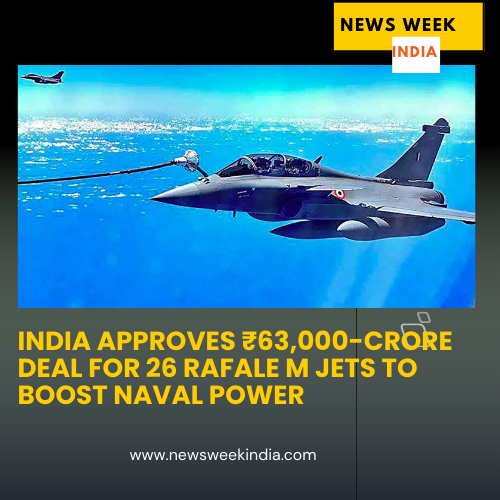India approves acquisition of 26 Rafale M jets for its Navy in a ₹63,000-crore deal with France. Learn how this move strengthens India’s maritime defense strategy.
India Approves ₹63,000-Crore Deal for 26 Rafale M Jets to Boost Naval Power
Table of Contents
In a major push to modernize its naval strike capabilities, the Indian government has cleared the purchase of 26 Rafale M (Marine) fighter jets from France in a record-breaking ₹63,000-crore government-to-government deal. This strategic decision marks the first major fighter jet acquisition for the Indian Navy and represents a significant milestone in India’s defense preparedness, especially in the Indian Ocean region.
A Strategic Shift in Naval Air Power
The Rafale M jets, built by French aerospace giant Dassault Aviation, will be deployed aboard INS Vikrant, India’s first indigenously-built aircraft carrier. The fleet will consist of 22 single-seater and 4 twin-seater variants, designed specifically for maritime operations.
According to defense ministry sources, this acquisition will complement the existing fleet of MiG-29K aircraft, which are currently operational from India’s older aircraft carrier, INS Vikramaditya. The induction of Rafale M jets will offer a generational leap in technology, precision, and operational range.
Why Rafale M? Advanced Features Set It Apart
The Rafale M is regarded as one of the most advanced carrier-based fighter jets in the world, equipped with cutting-edge technology and structural reinforcements designed for the demanding conditions of naval aviation. Key features include:
- Safran Group’s reinforced landing gear, optimized for deck landings.
- Folding wings for compact storage on aircraft carriers.
- A reinforced undercarriage and tailhook system for carrier operations.
- Advanced radar systems and avionics for multi-role combat capability.
These capabilities make the Rafale M an ideal fit for India’s expanding naval operations, particularly as the country looks to enhance maritime surveillance and strike capabilities in the Indian Ocean Region, amid increasing Chinese naval activity.
Long-Term Delivery Timeline, Indigenous Production Plans
The deal also includes a comprehensive maintenance and logistical support package, as well as offset obligations that will involve indigenous manufacturing of components—boosting India’s defense industrial base and aligning with the ‘Make in India’ initiative.
The final agreement is expected to be signed during French Defence Minister Sébastien Lecornu’s visit to India later this month, with deliveries scheduled to begin five years post-signing. Full induction into the Navy is projected to complete by 2031, according to official estimates.
Enhancing Joint Capability with the Indian Air Force
The Indian Air Force currently operates 36 Rafale ‘C’ variant jets from two northern bases. The addition of naval variants will not only bolster maritime defense but also enhance inter-operability between the Air Force and Navy.
One notable benefit includes upgrading the ‘buddy-buddy’ aerial refuelling system, allowing one aircraft to refuel another mid-air. This is expected to extend the operational range and endurance of both Air Force and Naval missions.
Future Outlook: Indigenous Fifth-Gen Fighters in Pipeline
Looking ahead, the Indian Navy also plans to induct twin-engine, deck-based fighters developed by DRDO, the naval counterpart to the Air Force’s Advanced Medium Combat Aircraft (AMCA) program. These fifth-generation jets are expected to enter service in the 2030s and play a pivotal role in future combat scenarios.
In December, Navy Chief Admiral Dinesh Tripathi emphasized the evolving naval strategy, stating, “We are tweaking our posture to negate any infringement in our area of operations and are ready to tackle threats from all neighbors.”
A Leap Toward Strategic Naval Supremacy
India’s decision to acquire Rafale M fighter jets is more than just a defense upgrade—it’s a clear signal of strategic intent. With growing maritime challenges and geopolitical shifts, enhancing naval air power ensures India can assertively protect its interests in the Indo-Pacific.
This deal not only strengthens India’s military ties with France but also adds a powerful deterrent to potential adversaries, reinforcing India’s position as a key maritime force in the region.
Also read: Google’s Next-Gen Foldable – Pixel 10 Pro Fold Leaks Reveal Exciting Specs and Features

